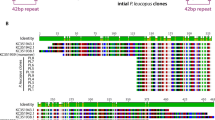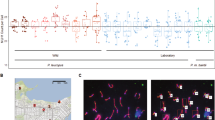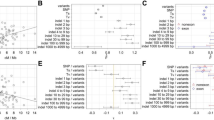Abstract
We investigated evolutionary trends of the 5S ribosomal RNA gene in the house mouse, Mus musculus. First, we assessed the 5S cluster and copy numbers in eight laboratory strains by pulsed-field gel electrophoresis. The copy numbers in seven lines were estimated to be around 130–170 copies per cluster, with 63 copies in the remaining strain, implying that the copy number can change drastically and has been maintained under certain evolutionary constraints at ~ 140 copies. Second, we addressed the frequency of meiotic recombination mediated by the 5S cluster by performing a mating experiment with laboratory strains, and found that the 5S cluster did not accelerate recombination events. Third, we surveyed recombination events of the 5S-containing chromosome region in wild mice from the Japanese Islands, where the two subspecies lineages, M. m. castaneus and M. m. musculus, are historically mingled, and found that the influence of the 5S cluster on meiotic recombination was limited. Finally, we examined the nucleotide diversity of six genes in the neighboring regions of the 5S cluster and found reduced genetic diversity in the regions on both sides of the cluster, suggesting the involvement of either positive or background selection in the population-level sequence similarity of the 5S clusters. Therefore, the mouse 5S genes are considered to be evolving toward sequence similarity within a given cluster by certain intrachromosomal mechanisms and toward sharing of a specific 5S cluster within a population by certain selective processes.


Similar content being viewed by others
References
Boursot P, Auffray JC, Britton-Davidian J, Bonhomme F (1993) The evolution of house mice. Annual Rev Ecol Syst 24:119–152
Braverman JM, Hudson RR, Kaplan NL, Langley CH, Stephan W (1995) The hitchhiking effect on the site frequency-spectrum of DNA polymorphisms. Genetics 140:783–796
Campo D, Machado-Schiaffino G, Horreo JL, Garcia-Vazquez E (2009) Molecular organization and evolution of 5S rDNA in the genus Merluccius and their phylogenetic implications. J Mol Evol 68:208–216
Charlesworth B, Morgan MT, Charlesworth D (1993) The effect of deleterious mutations on neutral molecular variation. Genetics 134:1289–1303
Charlesworth B, Sniegowski P, Stephan W (1994) The evolutionary dynamics of repetitive DNA in eukaryotes. Nature 371:215–220
Cohen S, Agmon N, Sobol O, Segal D (2010) Extrachromosomal circles of satellite repeats and 5S ribosomal DNA in human cells. Mobile DNA 1:11
Excoffier L, Lischer HEL (2010) Arlequin suite ver 3.5: a new series of programs to perform population genetics analyses under Linux and Windows. Mol Ecol Resour 10:564–567
Freire R, Arias A, Ínsua AM, Méndez J, Eirín-López JM (2010) Evolutionary dynamics of the 5S rDNA gene family in the mussel Mytilus: mixed effects of birth-and-death and concerted evolution. J Mol Evol 70:413–426
Fujiwara M, Inafuku J, Takeda A, Watanabe A, Fujiwara A, Kohno S, Kubota S (2009) Molecular organization of 5S rDNA in bitterlings (Cyprinidae). Genetica 135:355–365
Ganley ARD, Kobayashi T (2007) Highly efficient concerted evolution in the ribosomal DNA repeats: Total rDNA repeat variation revealed by whole-genome shotgun sequence data. Genome Res 17:184–191
Ganley ARD, Kobayashi T (2011) Monitoring the rate and dynamics of concerted evolution in the ribosomal DNA repeats of Saccharomyces cerevisiae using experimental evolution. Mol Biol Evol 28:2883–2891
Gaubatz J, Prashad N, Cutter RG (1976) Ribosomal RNA gene dosage as a function of tissue and age for mouse and human. Biochim Biophys Acta 418:358–375
Gibbons JG, Branco AT, Godinho SA, Yu S, Lemos B (2015) Concerted copy number variation balances ribosomal DNA dosage in human and mouse genomes. Proc Natl Acad Sci USA 24:2485–2490
Henderson AS, Atwood KC, Yu MT, Warburton D (1976) The site of 5S RNA genes in primates. Chromosoma 56:29–32
Hudson RR, Kreitman M, Aguadé M (1987) A test of neutral molecular evolution based on nucleotide data. Genetics 116:153–159
Huson DH, Bryant D (2006) Application of phylogenetic networks in evolutionary studies. Mol Biol Evol 23:254–267
Ide S, Saka K, Kobayashi T (2013) Rat 109 prevents hyper-amplification of ribosomal RNA genes through histone modification in budding yeast. PLoS Genet 9:e1003410
James SA, West C, Davey RP, Dicks J, Roberts IN (2016) Prevalence and dynamics of ribosomal DNA micro-heterogeneity are linked to population history in two contrasting yeast species. Sci Rep 6:28555
Jensen-Seaman MI, Furey TS, Payseur BA, Lu Y, Roskin KM, Chen C-F, Thomas MA, Haussler D, Jacob HJ (2004) Comparative recombination rates in the rat, mouse, and human genomes. Genome Res 14:528–538
Katakura K, Matsumoto Y, Gomez EA, Furuya M, Hashiguchi Y (1993) Molecular karyotype characterization of Leishmania panamensis. Leishmania mexicana, and Leishmania major-like parasites: agents of cutaneous leishmaniasis in Ecuador. Am J Trop Med Hyg 48:707–715
Kellogg EA, Appels R (1995) Intraspecific and interspecific variation in 5S RNA genes are decoupled in diploid wheat relatives. Genetics 140:325–343
Kobayashi T (2011) How does genome instability affect lifespan? Genes Cells 16:617–624
Kodama S, Nunome M, Moriwaki K, Suzuki H (2015) Ancient onset of geographical divergence, interpopulation genetic exchange, and natural selection on the Mc1r coat-colour gene in the house mouse (Mus musculus). Biol J Linn Soc 114:778–794
Kuwayama T, Nunome M, Kinoshita G, Abe K, Suzuki H (2017) Heterogeneous genetic makeup of the Japanese house mouse (Mus musculus) created by multiple independent introductions and spatio-temporally diverse hybridisation processes. Biol J Linn Soc 122:661–674
Liao D, Pavelitz T, Kidd JR, Kidd KK, Weiner AM (1997) Concerted evolution of the tandemly repeated genes encoding human U2 snRNA (the RNU2 locus) involves rapid intrachromosomal homogenization and rare interchromosomal gene conversion. EMBO J 16:588–598
Librado P, Rozas J (2009) DnaSP v5: a software for comprehensive analysis of DNA polymorphism data. Bioinformatics 25:1451–1452
Little RD, Braaten DC (1989) Genomic organization of human 5S rDNA and sequence of one tandem repeat. Genomics 4:376–383
Lomholt B, Frederiksen S, Jensen LR, Christensen K, Hallenberg C (1996) 5S rRNA genes in Macaca fascicularis map to chromosome 1p in three loci. Mamm Genome 7:451–453
Matsuda Y, Moriwaki K, Chapman VM, Hoi-Sen Y, Akbarzadeh J, Suzuki H (1994) Chromosomal mapping of mouse 5S rRNA genes by direct R-banding fluorescence in situ hybridization. Cytogenet Cell Genet 66:246–249
Maynard Smith J, Haigh J (1974) The hitch-hiking effect of a favourable gene. Genet Res 23:23–35
Nagylaki T (1984) Evolution of multigene families under interchromosomal gene conversion. Proc Natl Acad Sci USA 81:3796–3800
Nagylaki T, Petes TD (1982) Intrachromosomal gene conversion and the maintenance of sequence homogeneity among repeated genes. Genetics 100:315–337
Nei M, Rooney AP (2005) Concerted and birth-and-death evolution of multigene families. Annu Rev Genet 39:121–152
Nielsen R (2005) Molecular signatures of natural selection. Annu Rev Genet 39:197–218
Nunome M, Ishimori C, Aplin KP, Yonekawa H, Moriwaki K, Suzuki H (2010) Detection of recombinant haplotypes in wild mice (Mus musculus) provides new insights into the origin of Japanese mice. Mol Ecol 19:2474–2489
Ohta T (1980) Evolution and variation of multigene families. Springer, Berlin
Petes TD, Botstein D (1977) Simple Mendelian inheritance of the reiterated ribosomal DNA of yeast. Proc Natl Acad Sci USA 74:5091–5095
Pinhal D, Yoshimura TS, Araki CS, Martins C (2011) The 5S rDNA family evolves through concerted and birth-and-death evolution in fish genomes: an example from freshwater stingrays. BMC Evol Biol 11:151
Richard GF, Kerrest A, Dujon B (2008) Comparative genomics and molecular dynamics of DNA repeats in eukaryotes. Microbiol Mol Biol Rev 72:686–727
Rooney AP, Ward TJ (2005) Evolution of large ribosomal RNA multigene family in filamentous fungi: birth and death of a concerted evolution paradigm. Proc Natl Acad Sci USA 102:5084–5098
Schlotterer C, Hauser MT, von Haeseler A, Tautz D (1994) Comparative evolutionary analysis of rDNA ITS regions in Drosophila. Mol Biol Evol 11:513–522
Scoles GJ, Gill BS, Xin ZY, Clarke BC, McIntyre CL, Chapman C, Appels R (1998) Frequent duplication and deletion events in the 5S RNA genes and the associated spacer regions of the Triticeae. Plant Syst Evol 160:105–122
Smith GP (1976) Evolution of repeated DNA sequences by unequal crossover. Science 191:528–535
Sørensen PD, Frederiksen S (1991) Characterization of human 5S ribosomal RNA genes. Nucleic Acids Res 19:4147–4151
Sørensen PD, Lomholt B, Frederiksen S, Tommerup N (1991) Fine mapping of human 5S rRNA genes to chromosome 1q42.11 to q42.13. Cytogenet Cell Genet 57:26–29
Stage DE, Eickbush TH (2007) Sequence variation within the rRNA loci of 12 Drosophila species. Genome Res 17:1888–1897
Stephens M, Scheet P (2005) Accounting for decay of linkage disequilibrium in haplotype inference and missing-data imputation. Am J Hum Genet 76:449–462
Stephens M, Smith NJ, Donnelly P (2001) A new statistical method for haplotype reconstruction from population data. Am J Hum Genet 68:978–989
Stults DM, Killen MW, Pierce HH, Pierce AJ (2008) Genomic architecture and inheritance of human ribosomal RNA gene clusters. Genome Res 18:13–18
Suzuki H, Moriwaki K, Sakurai S (1994a) Sequences and evolutionary analysis of mouse 5S rDNAs. Mol Biol Evol 11:704–710
Suzuki H, Tsuchiya K, Sakaizumi M, Wakana S, Sakurai S (1994b) Evolution of restriction sites of ribosomal DNA in natural populations of the field mouse, Apodemus speciosus. J Mol Evol 38:107–112
Suzuki H, Sakurai S, Matsuda Y (1996) Rat rDNA spacer sequences and chromosomal assignment of the genes to the extreme terminal region of chromosome 19. Cytogenet Cell Genet 72:1–4
Suzuki H, Nunome M, Kinoshita G, Aplin KP, Vogel P, Kryukov AP, Jin M-L, Han S-H, Maryanto I, Tsuchiya K, Ikeda H, Shiroishi T, Yonekawa H, Moriwaki K (2013) Evolutionary and dispersal history of Eurasian house mice Mus musculus clarified by more extensive geographic sampling of mitochondrial DNA. Heredity 111:375–390
Takada T, Ebata T, Noguchi H, Keane TM, Adams DJ, Narita T, Shin T, Fujisawa H, Toyoda A, Abe K, Obata Y (2013) The ancestor of extant Japanese fancy mice contributed to the mosaic genomes of classical inbred strains. Genome Res 23:1329–1338
Takada T, Yoshiki A, Obata Y, Yamazaki Y, Shiroishi T (2015) NIG_MoG: a mouse genome navigator for exploring intersubspecific genetic polymorphisms. Mamm Genome 26:331–337
Tamura K, Peterson D, Peterson N, Stecher G, Nei M, Kumar S (2011) MEGA5: molecular evolutionary genetics analysis using maximum likelihood, evolutionary distance, and maximum parsimony methods. Mol Biol Evol 28:2731–2739
Vierna J, Gonzalez-Tizon A, Martinez-Lage A (2009) Long-term evolution of 5S ribosomal DNA seems to be driven by birth-and-death processes and selection in Ensis razor shells (mollusca: Bivalvia). Biochem Genet 47:635–644
Vizoso M, Vierna J, González-Tizón AM, Martínez-Lage A (2011) The 5S rDNA gene family in mollusks: characterization of transcriptional regulatory regions, prediction of secondary structures, and long-term evolution, with special attention to Mytilidae mussels. J Hered 102:433–447
Yu S, Lemos B (2016) A portrait of ribosomal DNA contacts with Hi-C reveals 5S and 45S rDNA anchoring points in the folded human genome. Genome Biol Evol 8:3545–3558
Acknowledgements
We would like to thank Kuniya Abe, Gohta Kinoshita, Motoko Kobayashi, Nobumoto Miyashita, Ritsuko Nakayama, Kazuo Moriwaki, Masahiko Nishimura, Susumu Sakurai, Toshihiko Shiroishi, Toyoyuki Takada, Mie Terashima, Kimiyuki Tsuchiya, Hiromichi Yonekawa, and Shigeharu Wakana for providing valuable comments on an earlier manuscript resulting from this study. We thank two anonymous reviewers for their comments that helped improve the manuscript. This study was supported by a grant-in-aid for Scientific Research (C) to HS (No. 15K07177) from the Japan Society for the Promotion of Science.
Author information
Authors and Affiliations
Corresponding author
Electronic supplementary material
Below is the link to the electronic supplementary material.
Rights and permissions
About this article
Cite this article
Isobe, M., Nunome, M., Katakura, K. et al. Evolutionary Dynamics of Copy Number and Meiotic Recombination in Murine 5S rDNA: Possible Involvement of Natural Selection. J Mol Evol 86, 312–323 (2018). https://doi.org/10.1007/s00239-018-9848-6
Received:
Accepted:
Published:
Issue Date:
DOI: https://doi.org/10.1007/s00239-018-9848-6




